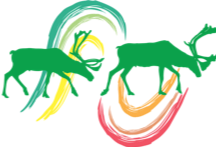About the Management Authorities
Contact information for each management authority can be found here.
Mandate
The Gwich'in Renewable Resources Board (GRRB) was established under the guidance of the Gwich’in Comprehensive Land Claim Agreement (GCLCA) to be the main instrument of wildlife, fish and forest management in the Gwich'in Settlement Area (GSA). The Board acts in the public interest, representing all the parties to the Gwich’in Comprehensive Land Claim Agreement (GCLCA) – the Gwich’in, the people of the Northwest Territories, and all Canadians.
Mission
The GRRB works in cooperation with the Gwich’in people, governments and stakeholders, and in accordance with the Gwich’in Comprehensive Land Claim Agreement to effectively protect, conserve, and manage renewable resources in the Gwich’in Settlement Area. It does this in a respectful, transparent, communicative, and inclusive manner, using the best available traditional and scientific knowledge.
“The Ɂehdzo Got’ı̨nę Gots’ę́ Nákedı (Sahtú Renewable Resources Board). is one of three co-management boards in the Sahtú Region. It was established by the Sahtú Dene and Metis Comprehensive Land Claim Agreement of 1993 (SDMCLCA) as the main instrument of management for wildlife and wildlife habitat in the Sahtú Region of the Northwest Territories along with the Ɂehdzo Got’ı̨nę (Renewable Resources Councils). Our Dene name means “Helpers of the Ɂehdzo Got’ı̨nę, the Trap People”. We have formally adopted an approach “rooted in Dene ts’ı̨lı̨ (Dene ways of life) and community conservation planning.”
The Wildlife Management Advisory Council (NWT) is the main instrument of wildlife management in the Inuvialuit Settlement Region (Western Arctic Region) of the NWT. The WMAC (NWT) advises the federal and territorial governments on wildlife policy, management, regulation, and administration of wildlife, habitat and harvesting in the Inuvialuit Settlement Region (ISR) (IFA, section 14). These recommendations are based on best available information including TK, local knowledge and science. The WMAC (NWT) works collaboratively with the Inuvialuit Game Council, HTCs, and other governments in research, monitoring and management of wildlife and their habitat. The WMAC (NWT) recommends appropriate quotas for Inuvialuit wildlife harvesting, including TAH for caribou when appropriate.
The Wek’èezhìı Renewable Resources Board (WRRB) is responsible for managing wildlife and wildlife habitat (forest, plants, protected areas) in Wek’èezhìı. The WRRB is an institution of public government and is responsible for working with Tłı̨chǫ communities and the public to ensure renewable resources in Wek’èezhìı are managed in a sustainable manner.
The WRRB operates on a co-management basis in the management of resources. The Board works collaboratively with Tłı̨chǫ communities; Indigenous, territorial and federal governments; regional renewable resources boards; and regulatory authorities.
The Kitikmeot Regional Wildlife Board (KRWB) is a Regional Wildlife Organization (RWO) under the Nunavut Land Claims Agreement (NLCA). As such, the KRWB is responsible for the allocation and enforcement of the regional BNL among the Hunters and Trappers Organizations (HTOs) in the Region and the regulation of harvesting practices among the members of the HTOs.
The Tuktut Nogait National Park Management Board is the primary instrument through which the parties to the Tuktut Nogait Agreement collaborate in the management of the Park. The Board advises the Minister of the Environment and other ministers as appropriate on all aspects of park planning, operation and management, and on the means of accomplishing the Park’s defined purposes.
The Tuktut Nogait Agreement is a comprehensive agreement that sets the direction for park management, along with the Inuvialuit Final Agreement, the Canada National Parks Act and Regulations, national park policy, and other applicable legislation and regulations. The Agreement defines the purposes of Tuktut Nogait and the mandate of the Board. The Agreement also touches on training and community development planning, harvesting rights within the Park, contracting priorities for Inuvialuit, Inuvialuit priorities for park business licenses and access, and the use of firearms.






